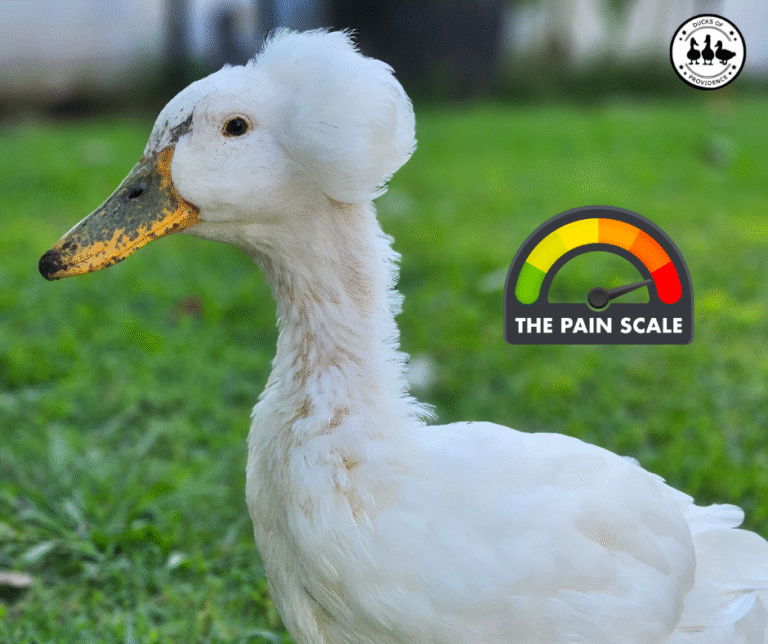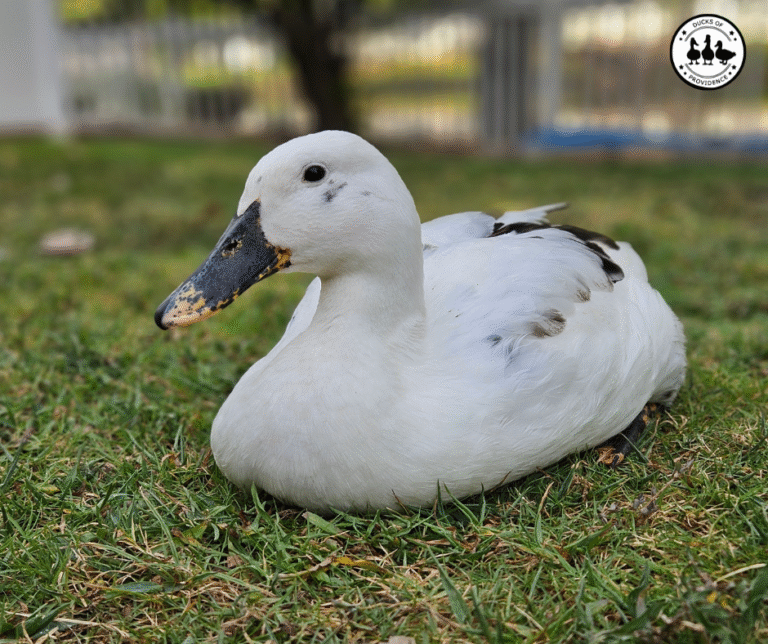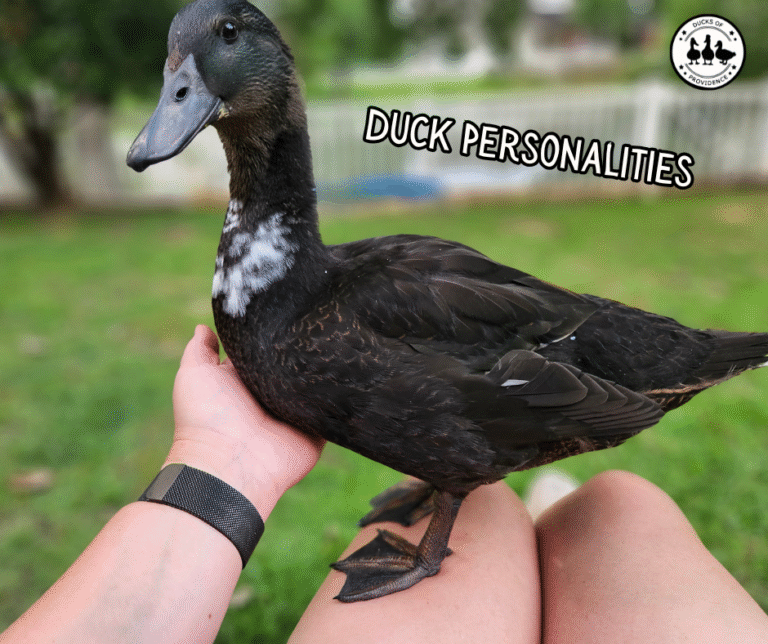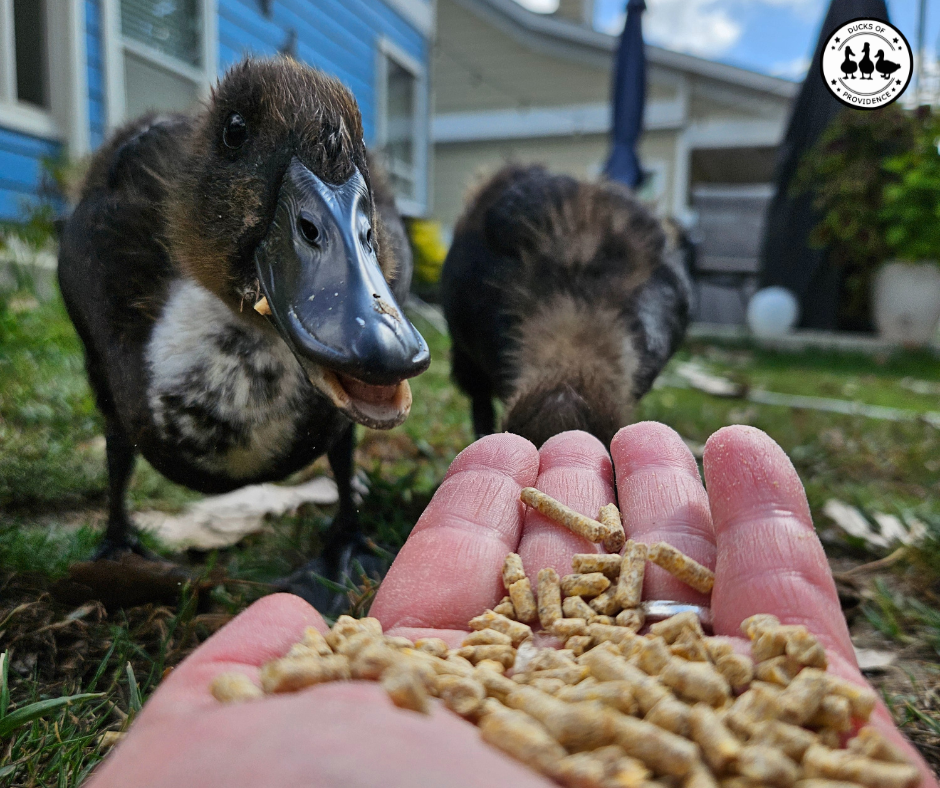
Foods Ducks Can and Can’t Eat: The Ultimate Guide for Pet Owners
Ducks are curious eaters, and as a duck parent, it’s natural to wonder what’s safe to share with your flock. While some fruits, vegetables, and treats can boost their health and bring joy to their day, others can cause serious harm. In this complete guide to foods ducks can and can’t eat, we break down everything by category—fruits, veggies, grains, proteins, snacks, and more—so you can feel confident in what goes in their bowl. Backed by research and our experience with our own flock, this is the trusted resource you’ve been looking for.
Ducks of Providence is free, thanks to reader support! Ads and affiliate links help us cover costs—if you shop through our links, we may earn a small commission at no extra cost to you. Thanks for helping keep our content free and our ducks happy! 🦆 Learn more
A Quick Note on Balance and Portion Control
While ducks can enjoy a wide range of foods, moderation is key. Treats—including fruits and grains—should make up no more than 10% of your ducks’ daily intake. The foundation of their diet should always be a complete, nutritionally balanced duck feed formulated for their age and purpose (maintenance, laying, etc.).
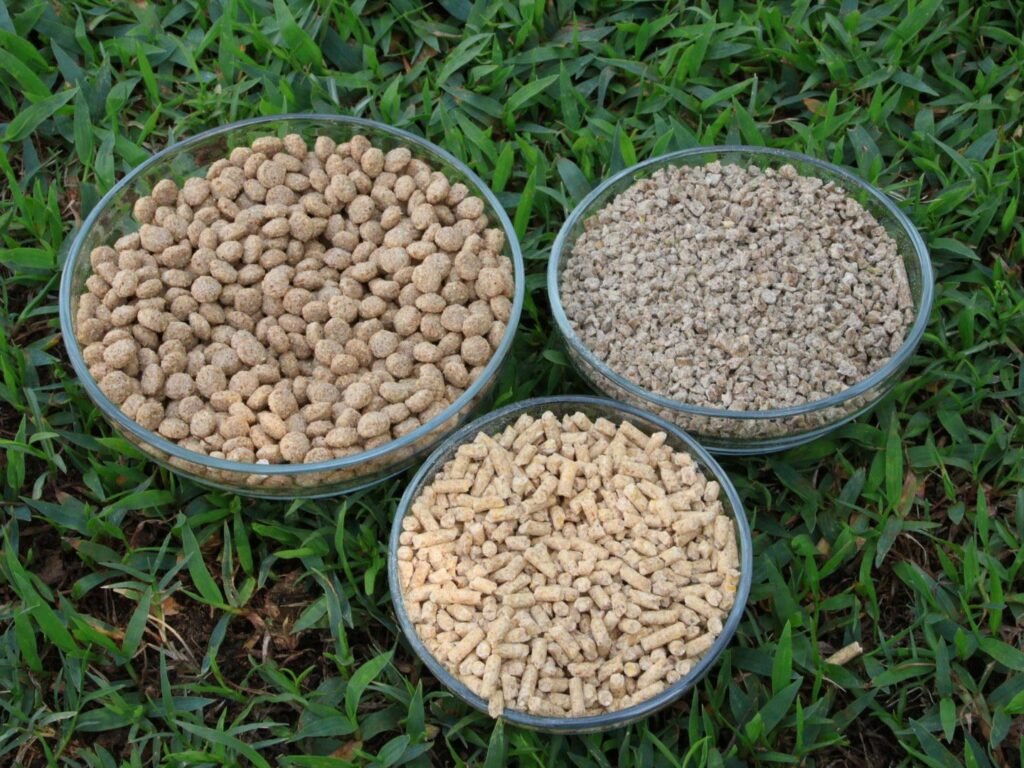
Offering too many extras can lead to nutrient imbalances, obesity, and even health issues like reproductive problems or angel wing.
For a deeper look at what ducks need to thrive, including information on essential nutrients, protein levels, and feeding tips, check out our detailed post:
👉 Understanding Your Duck’s Nutritional Needs
Fruits Ducks Can and Can’t Eat
Fruits are often a duck’s favorite—sweet, juicy, and easy to peck at. Many are rich in vitamins and water content, making them a refreshing treat, especially in hot weather. But not all fruits are duck-safe. Some contain toxic parts like pits or seeds, and others can upset their digestion if overfed.
Below is a list of fruits that are safe, should be fed in moderation, or avoided altogether.
| Fruit | Safe to Feed? | Notes |
|---|---|---|
| Blueberries | ✅ Good | Antioxidant-rich; soft and safe |
| Strawberries | ✅ Good | Low in sugar; mash for easier eating |
| Raspberries | ✅ Good | High in fiber; a bit messy but nutritious |
| Blackberries | ✅ Good | Nutrient-dense; mash if large |
| Mulberries | ✅ Good | Seasonal treat; feed ripe |
| Cranberries | ✅ Good | Fresh only; avoid sweetened or dried |
| Apples | ✅ Good | No seeds; chop or slice |
| Pears | ✅ Good | No seeds; soft and hydrating |
| Quince | ⚠️ Moderation | Astringent raw; better cooked, feed sparingly |
| Cherries | ⚠️ Moderation | Remove pits; high sugar |
| Plums | ⚠️ Moderation | Remove pits; small slices only |
| Peaches | ⚠️ Moderation | Remove pits; feed ripe and soft |
| Nectarines | ⚠️ Moderation | Remove pits; same as peaches |
| Apricots | ⚠️ Moderation | Remove pit; ripe flesh only |
| Mangoes | ⚠️ Moderation | Remove skin and pit; sugary and sticky |
| Watermelon | ✅ Good | Hydrating; remove seeds and rind |
| Cantaloupe | ✅ Good | Remove rind and seeds |
| Honeydew | ✅ Good | Same as cantaloupe; serve in small bits |
| Oranges | ⚠️ Moderation | Acidic; can upset digestion |
| Tangerines | ⚠️ Moderation | Same as oranges |
| Lemons | ❌ Bad | Too acidic; avoid entirely |
| Limes | ❌ Bad | Too acidic; avoid entirely |
| Grapefruit | ❌ Bad | High acidity and bitter oils |
| Papaya | ⚠️ Moderation | Remove seeds; soft and sweet |
| Pineapple | ⚠️ Moderation | Remove skin/core; acidic, offer small amounts |
| Banana | ✅ Good | No peel; soft and sweet |
| Passionfruit | ⚠️ Moderation | Remove seeds; feed ripe pulp only |
| Dragon fruit | ✅ Good | High water content; low sugar |
| Guava | ⚠️ Moderation | Remove seeds; can be seedy and firm |
| Grapes | ✅ Good | Cut in half; high in sugar |
| Kiwi | ✅ Good | Remove skin; feed in small pieces |
| Pomegranate | ⚠️ Moderation | Seeds may be hard to digest; offer small amounts |
| Figs | ⚠️ Moderation | High sugar; sticky; offer sparingly |
| Dates | ❌ Bad | Too sugary, especially dried |
| Persimmon | ⚠️ Moderation | Only fully ripe; unripe fruit is very astringent |
| Avocado | ❌ Bad | Toxic (especially skin and pit); avoid entirely |
| Coconut | ⚠️ Moderation | High in fat; offer fresh, shredded only in tiny amounts |
Understanding Fruit Choices for Ducks
Fruits can be a tasty, vitamin-rich supplement in your ducks’ diet—but only in moderation. Ducks enjoy the natural sweetness and moisture, but because their digestive systems aren’t designed for high sugar intake, overfeeding fruit can lead to problems like obesity, yeast infections (vent gleet), and disrupted calcium absorption, especially in laying hens.
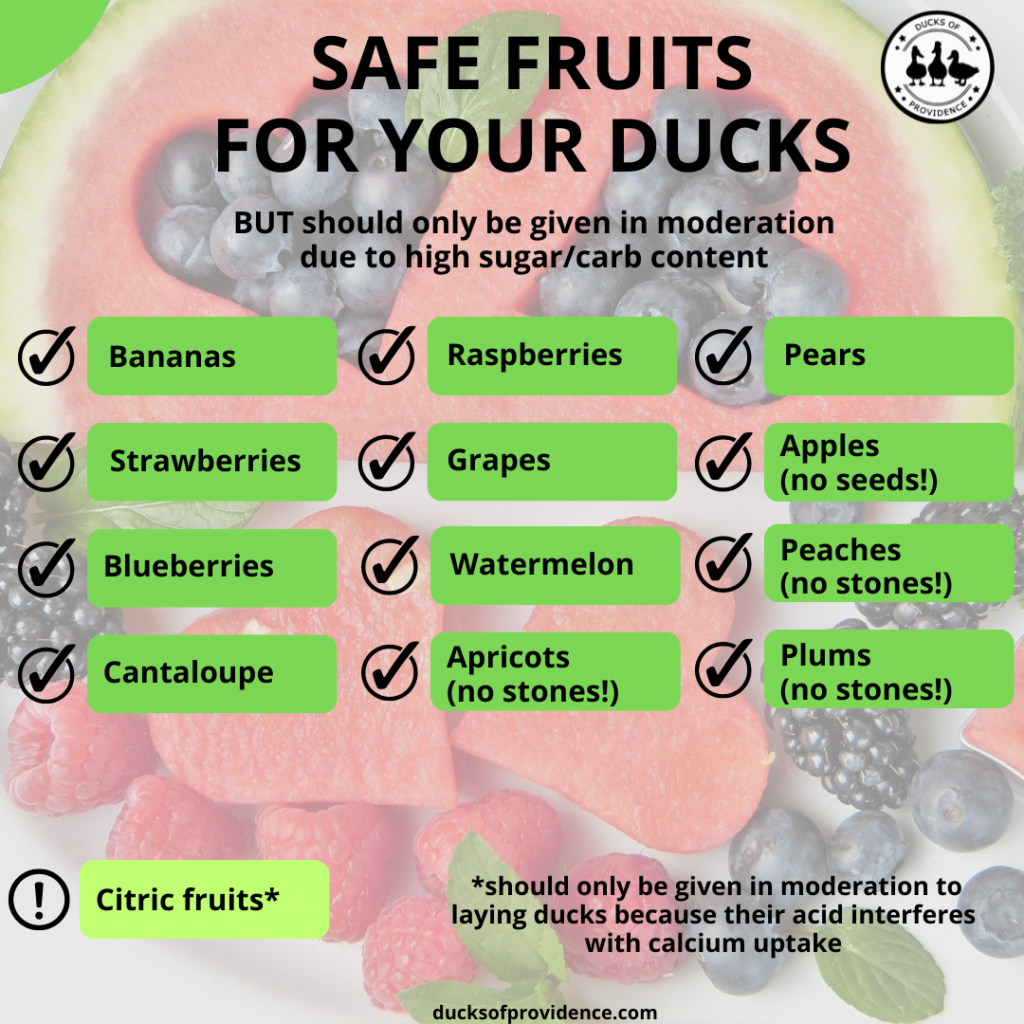
Here’s a closer look at why some fruits are better than others:
✅ Safe Fruits for Ducks and Why They Are Beneficial
- Berries (like blueberries, raspberries, and blackberries) are rich in antioxidants and low in sugar, making them some of the healthiest fruit choices.
- Melons (like watermelon and cantaloupe) have high water content, which helps keep ducks hydrated—especially in warm weather.
- Bananas and pears provide potassium and fiber but should be fed in small amounts due to their higher sugar content.
- Apples are fine in moderation, but always remove the seeds, which contain amygdalin—a compound that releases cyanide when digested.
⚠️ Why Some Fruits Should Only Be Given Occasionally
- Citrus fruits (like oranges and mandarins) are acidic. While not toxic, they can upset a duck’s digestive balance and may interfere with calcium uptake.
- Mango and pineapple are sweet and sometimes stringy or sticky, which can pose a choking hazard or stick to feathers, attracting dirt and bacteria.
- Cherries and papaya are safe if fully ripe and seedless, but their pits and seeds must always be removed, as they pose both toxicity and choking risks.
❌ Why Certain Fruits Are Dangerous
- Avocado is one of the most dangerous fruits for ducks. Its skin, pit, and possibly even the flesh contain persin—a toxin that can cause heart damage and respiratory distress.
- Fruit pits and seeds from stone fruits like cherries, peaches, apricots, and apples can contain cyanide-forming compounds. Even a small amount may be harmful.
- Dried fruits, while seemingly harmless, are concentrated sources of sugar and often contain preservatives like sulfur dioxide that can upset a duck’s gut.
Vegetables Ducks Can and Can’t Eat
Vegetables are a fantastic way to supplement your ducks’ diet with fiber, vitamins, and minerals. Leafy greens and crunchy veggies mimic the types of plants ducks might forage naturally. However, some vegetables—especially those from the nightshade family—can be dangerous if consumed.
Here’s what to feed (and what to avoid) when it comes to vegetables.
| Vegetable | Safe to Feed? | Notes |
|---|---|---|
| Kale | ✅ Good | High in calcium; great chopped or shredded |
| Swiss chard | ✅ Good | Nutrient-dense; rotate with other greens |
| Collard greens | ✅ Good | Strong flavor; rich in calcium |
| Mustard greens | ✅ Good | Can be spicy; offer in moderation |
| Beet greens | ✅ Good | Great leafy green; feed fresh |
| Lettuce (various) | ✅ Good | Romaine and leaf lettuce preferred; iceberg low in nutrition |
| Arugula | ✅ Good | Peppery taste; rotate with milder greens |
| Spinach | ⚠️ Moderation | High in oxalates; can interfere with calcium |
| Broccoli | ✅ Good | Chop finely; feed raw or lightly steamed |
| Cauliflower | ⚠️ Moderation | May cause gas; small amounts only |
| Cabbage | ⚠️ Moderation | Same as cauliflower; feed shredded |
| Brussels sprouts | ⚠️ Moderation | Gassy vegetable; small portions |
| Celery | ✅ Good | Chop finely to avoid stringy texture |
| Fennel | ⚠️ Moderation | Strong flavor; test with small amounts |
| Carrots | ✅ Good | Grate or chop; rich in beta-carotene |
| Beets | ✅ Good | Feed grated raw or cooked; may tint droppings |
| Turnips | ⚠️ Moderation | Slightly bitter raw; better cooked |
| Parsnips | ⚠️ Moderation | Feed cooked; raw may be too tough |
| Radishes | ⚠️ Moderation | Peppery taste; not all ducks like them |
| Sweet potatoes | ✅ Good | Cooked only; high in nutrients |
| Regular potatoes | ❌ Bad | Raw (especially green parts) are toxic |
| Zucchini | ✅ Good | Mild flavor; feed raw or cooked |
| Cucumber | ✅ Good | High in water; refreshing treat |
| Pumpkin | ✅ Good | Raw or cooked; ducks enjoy flesh and seeds (unsalted) |
| Winter squash | ✅ Good | Cooked flesh only; high in beta-carotene |
| Summer squash | ✅ Good | Similar to zucchini; easy to digest |
| Peppers (bell) | ✅ Good | Remove seeds; avoid spicy peppers |
| Tomatoes | ⚠️ Moderation | Only ripe fruit; stems/leaves are toxic |
| Eggplant | ❌ Bad | Toxic leaves; fruit may be okay cooked but best avoided |
| Corn | ✅ Good | Fresh or thawed frozen kernels; whole or on cob |
| Green beans | ✅ Good | Serve raw or cooked; remove ends |
| Snow peas | ✅ Good | Young pods are great raw |
| Parsley | ✅ Good | Safe herb; rich in vitamins |
| Basil | ✅ Good | Mild flavor; feed in moderation |
| Mint | ✅ Good | Refreshing and duck-safe; strong flavor |
| Dill | ✅ Good | Mild herb; safe in small quantities |
| Cilantro | ✅ Good | Safe and flavorful |
| Oregano | ✅ Good | Strong flavor; may have natural antimicrobial properties |
| Thyme | ✅ Good | Feed sparingly; aromatic herb |
| Chives | ❌ Bad | Belongs to onion family; can cause digestive upset |
Understanding Vegetables in a Duck’s Diet
Vegetables are one of the most nutritious and enriching additions you can offer your ducks. Many provide essential vitamins (like A, C, and K), minerals, and fiber that support immune health, egg production, and digestion. But not all veggies are duck-safe—some can interfere with nutrient absorption, and others are outright toxic.
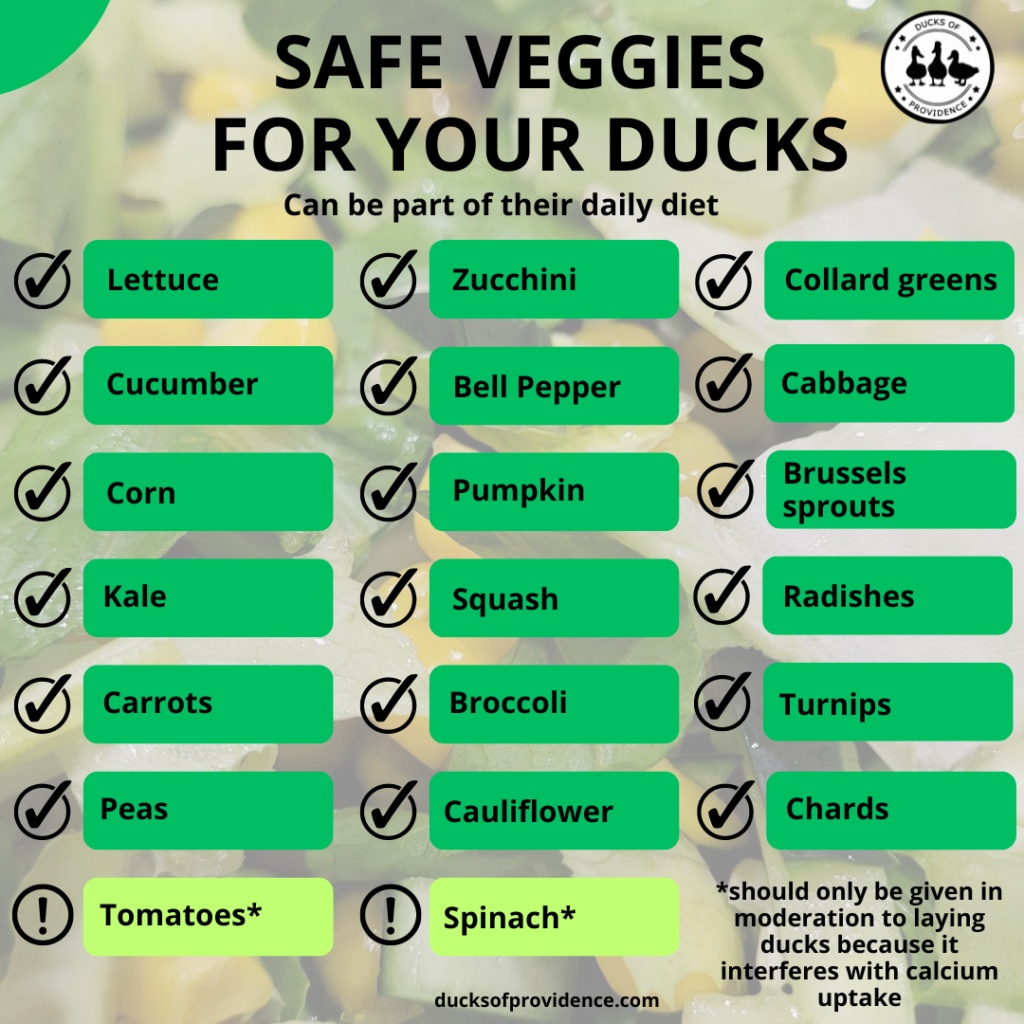
Here’s what duck keepers should understand when offering vegetables:
✅ Why the Safe Vegetables Are Great for Ducks
- Leafy greens like romaine, kale, Swiss chard, and dandelion greens are packed with nutrients and mimic the foraging behavior ducks enjoy in the wild.
- Peas and corn are rich in energy and protein—ideal for growing ducks or birds in molt.
- Carrots, pumpkin, and sweet potatoes offer beta-carotene (a vitamin A precursor) and fiber. Always chop or grate harder veggies to prevent choking.
- Cucumbers and zucchini are hydrating and low in calories—great summer snacks.
⚠️ Why Some Vegetables Should Be Fed in Moderation
- Spinach is nutritious, but it contains oxalic acid, which binds to calcium in the gut and can lead to deficiencies—especially concerning in laying ducks.
- Iceberg lettuce is very low in nutrients and mostly water. While not dangerous, it fills ducks up without providing value and can cause diarrhea if overfed.
- Cauliflower and other cruciferous veggies can cause bloating or digestive upset when fed in large amounts raw.
❌ Why Some Vegetables (and Plant Parts) Are Dangerous
- Onions and garlic contain compounds that can damage red blood cells and lead to anemia. Even small amounts regularly can cause harm over time.
- Raw potatoes (especially green parts) contain solanine, a natural pesticide that’s highly toxic to ducks (and humans).
- Rhubarb is a major hazard—the leaves, in particular, contain oxalates that can cause kidney failure.
- Nightshade plants like tomatoes, eggplant, and peppers need special consideration:
- Ripe tomato fruit is generally safe in moderation (and technically a fruit), but leaves and stems are toxic.
- Eggplant and pepper leaves should be avoided entirely.
- Always supervise access to gardens that include these plants.
Grains and Seeds for Ducks: Safe and Unsafe Options
Grains provide ducks with carbohydrates for energy, but not all grains are created equal. Whole, cooked grains like oats and brown rice are great additions, while large or dry seeds can cause choking. Others, like uncooked beans, are outright toxic.
Use the table below to make safe grain choices for your flock.
| Food Item | Safe to Feed? | Notes |
|---|---|---|
| Oats | ✅ Good | Whole oats provide digestible carbohydrates and fiber (ducksofprovidence.com) |
| Barley | ✅ Good | High-energy grain; feed cooked or cracked for easier digestion |
| Brown rice | ✅ Good | Cooked, easier to digest; supports carb needs without overloading |
| Quinoa | ✅ Good | Cooked quinoa provides complete proteins and carbs |
| Whole grain bread | ✅ Good | Only small amounts; occasional treat |
| Cracked corn | ✅ Good | Energy boost; ensure free-choice access |
| White rice | ⚠️ Moderation | Feeds energy but lacks nutrients of whole grains |
| Refined breads | ⚠️ Moderation | Low nutrition; fine occasionally |
| Wheat | ⚠️ Moderation | Digestible but can cause bloating if overfed |
| Uncooked beans | ❌ Bad | Contain lectins harmful to ducks |
| Large dry grains | ❌ Bad | Risk of swelling/choking; cook or crack before feeding |
Understanding Grains and Seeds in the Duck Diet
Grains are a staple energy source for ducks. In the wild, waterfowl consume a variety of seeds and grains during migration or overwintering, and in captivity, many commercial duck feeds are grain-based. But the type, form, and preparation of grains matter a lot for safety and digestibility.

Here’s what to keep in mind when offering grains to pet ducks:
✅ Why the Good Grains Are Beneficial
- Whole oats, barley, brown rice, and quinoa are excellent sources of complex carbohydrates. They help maintain energy, especially in colder months, and provide important B vitamins and fiber.
- Cracked corn is a favorite for many ducks. It’s high in calories and works well as a cold-weather supplement—but should not be the primary food due to its low protein and calcium.
- Whole grain bread or plain cereal like unsweetened Cheerios can be a fun, occasional enrichment treat. They’re far better than white bread, which has little to no nutritional value.
⚠️ Why Some Grains Should Be Limited
- White rice and refined breads are easy to digest but low in nutrients. While not harmful, they don’t provide enough value to justify regular feeding.
- Wheat is safe in small amounts but may cause bloating or sticky droppings if overfed. Some ducks also have a harder time digesting it, especially if it’s not cracked or cooked.
❌ Why Some Grains and Seeds Are Dangerous
- Uncooked beans, especially kidney beans, are highly toxic due to lectins—plant proteins that can cause digestive distress, red blood cell damage, or even death.
- Large dry grains like dried corn kernels or whole wheat berries can swell in a duck’s crop or digestive tract, causing blockages. To be safe, always soak, cook, or crack large grains before feeding.
- Raw or spoiled grains can develop mold (e.g., aflatoxins) that are extremely toxic to birds.
💡 Quick Tip
When supplementing with grains, always consider your duck’s activity level, season, and life stage. For example:
- A molting or laying duck needs more protein than what cracked corn provides.
- In summer, limit grains to avoid excess weight gain.
- In winter, a little extra grain can support body warmth and energy needs.
Protein and Animal-Based Foods for Ducks
Ducks need protein to support healthy feathers, egg production, and growth—especially during molting. Naturally foraging ducks eat insects and larvae, and we can replicate this with safe options like mealworms and black soldier fly larvae. However, not all protein-rich foods are duck-friendly.
This list shows which animal-based proteins are safe, which should be used sparingly, and what to avoid completely.
| Food Item | Safe to Feed? | Notes |
|---|---|---|
| Hard-boiled eggs | ✅ Good | Chop into small pieces; avoid feeding raw eggs to prevent bad habits |
| Mealworms | ✅ Good | Excellent protein source; great during molting |
| Black soldier fly larvae | ✅ Good | High in calcium and protein; a sustainable option |
| Earthworms | ✅ Good | Natural foragers love them; feed only if pesticide-free |
| Crickets | ✅ Good | Nutritious and natural; live or dried |
| Cooked fish | ✅ Good | Plain, boneless, unseasoned |
| Live fish (e.g., minnows) | ✅ Good | Natural protein source; great enrichment if parasite-free |
| Cat or dog kibble | ⚠️ Moderation | High in protein; occasional supplement only |
| Canned tuna (in water) | ⚠️ Moderation | Occasional boost; only unsalted and unseasoned |
| Raw meat | ❌ Bad | High bacteria risk; avoid feeding |
| Processed meats | ❌ Bad | Too salty and heavily preserved |
| Bacon or deli meats | ❌ Bad | Extremely high in sodium, fat, and additives |
| Seasoned/salty foods | ❌ Bad | Salt toxicity is a real risk for ducks |
| Raw eggs | ❌ Bad | Can lead to egg-eating and bacterial risks |
Understanding Protein and Animal Products in a Duck’s Diet
Protein is essential for ducks—it supports feather health, muscle development, egg production, immune function, and overall vitality. While commercial duck feed provides a baseline protein level appropriate for your ducks’ life stage, supplemental protein from animal sources can be incredibly valuable—especially during molting, growth, or recovery from illness.
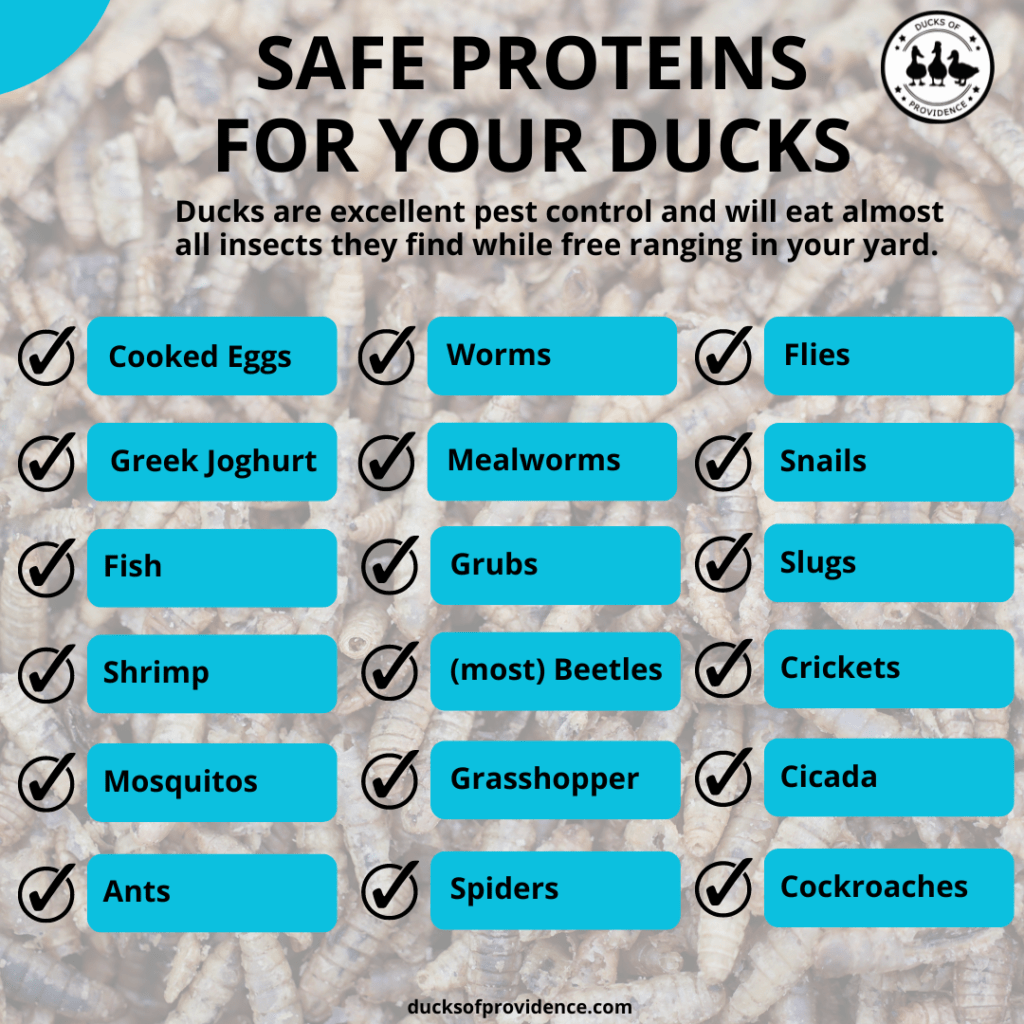
That said, not all protein-rich foods are safe, and some commonly offered items can pose serious health risks.
✅ Why These Protein Sources Are Great
- Mealworms, black soldier fly larvae, earthworms, and crickets mimic natural foraging behavior and are highly digestible sources of protein and calcium.
- Hard-boiled eggs (chopped, no shell unless finely crushed) offer complete protein and healthy fats. Ducks benefit from the nutrients—but feeding raw eggs can encourage egg-eating, so always cook them.
- Cooked fish and live minnows are excellent sources of lean protein and omega-3 fatty acids. Just ensure they’re plain, unsalted, and free from bones, and never collected from pesticide-treated waters.
- These foods are especially helpful for laying ducks, molting ducks, and young ducklings transitioning to grower feed.
⚠️ Why Some Items Should Be Offered Sparingly
- Cat or dog kibble can be used in emergencies for a protein boost, especially in underweight or recovering ducks. However, it’s not formulated for birds and often contains excess fat, salt, and additives.
- Canned tuna in water (not oil) is occasionally fine, but should never replace a balanced poultry diet.
- Shredded cheese (added in our dairy section) also counts here—it provides protein but should be limited due to fat and salt content.
❌ Why Some Protein-Rich Foods Are Unsafe
- Raw meat can harbor harmful bacteria like Salmonella and E. coli. Ducks don’t have the same digestive defenses as carnivores, so raw meat is a no-go.
- Processed meats (like bacon, sausage, hot dogs, and deli meats) are high in preservatives, sodium, and fats that ducks simply can’t process safely.
- Seasoned or salty foods like jerky, cured meats, or table scraps may seem tempting, but sodium toxicity in ducks is real and can cause neurological issues or death.
- Raw eggs should be avoided because they can lead to egg-eating behavior—a difficult habit to break and a serious concern for laying hens.
💡 Did You Know?
Some backyard duck keepers use insect-based treats as training rewards or to encourage foraging behavior in water bowls or grass. Sprinkling a few dried mealworms or BSFL into a bowl of water encourages natural dabbling instincts and provides enrichment along with nutrition.
Dairy and Ducks: A Tricky Combo
Ducks aren’t built to digest dairy. While small amounts of plain yogurt or cottage cheese might be tolerated, too much dairy can lead to digestive issues. Most cheese, milk, and ice cream are best left off the menu.
Check the table below for what’s acceptable and what to skip.
| Food Item | Safe to Feed? | Notes |
|---|---|---|
| Plain Greek yogurt | ⚠️ Moderation | Lower in lactose and higher in protein; best dairy option |
| Plain yogurt | ⚠️ Moderation | Some ducks tolerate small amounts; choose unsweetened |
| Cottage cheese | ⚠️ Moderation | Mild and soft; feed sparingly due to salt and lactose |
| Kefir (unsweetened) | ⚠️ Moderation | Fermented and easier to digest; can support gut health |
| Shredded cheese | ⚠️ Moderation | Small amounts of mild, low-sodium cheese are okay as a rare treat |
| Hard cheese | ❌ Bad | Block cheese is high in fat and salt; hard to digest in larger pieces |
| Milk | ❌ Bad | Ducks are lactose intolerant; causes digestive upset |
| Ice cream | ❌ Bad | Too much sugar and dairy; often includes additives |
| Cream/whipped cream | ❌ Bad | High fat and no nutritional benefit for ducks |
Understanding Dairy in a Duck’s Diet
Dairy products are not a natural part of a duck’s diet. Ducks, like most birds, lack the enzyme lactase, which is needed to properly digest lactose—the sugar found in milk. This makes dairy difficult for them to process and potentially irritating to their digestive systems. That said, some duck owners (ourselves included!) have found that a few fermented or low-lactose dairy products can be tolerated in very small amounts.
Here’s how to approach dairy with caution:
⚠️ Why Some Dairy Items Are Tolerable in Moderation
- Plain Greek yogurt and plain unsweetened yogurt are often the best-tolerated forms of dairy because the fermentation process breaks down much of the lactose. When offered in small amounts, they can even support gut health due to live probiotic cultures.
- Cottage cheese is soft, high in protein, and low in lactose compared to harder cheeses. A small spoonful can make a high-value treat, especially when mixed with chopped greens or oats.
- Kefir (unsweetened) is another fermented option that some duck keepers use in small amounts as a probiotic boost.
- Shredded cheese, especially mild varieties like mozzarella, can be offered very occasionally in tiny bits—as long as it’s low in salt and not processed.
These items should never be a daily snack and should be used only as a rare, enrichment-style treat, especially if your ducks tolerate them well.
❌ Why Most Dairy Should Be Avoided
- Milk, cream, ice cream, and whipped cream are high in both lactose and fat, and ducks have a hard time processing either. Feeding these may lead to diarrhea, crop imbalance, or long-term gut irritation.
- Hard cheeses and processed cheeses (like American cheese slices) are especially problematic due to added salt, preservatives, and casein proteins that are hard to digest.
- Flavored or sweetened yogurts often contain sugar or artificial sweeteners, which can be harmful to ducks.
💡 Your Ducks, Your Call
As with any treat, observe how your ducks respond. A healthy duck may tolerate a small spoon of plain yogurt once in a while with no issues, while another might show digestive upset after even a taste. When in doubt, it’s always better to skip dairy or stick to other high-protein treats like insects or eggs.
Treats and Snacks: Fun Extras (With Limits)
Whether it’s a handful of Cheerios or some freeze-dried mealworms, treats can be a fun way to bond with your ducks or add variety to their day. Just be sure to keep treats limited and avoid anything processed, salty, or sugary.
Use this table to see which snacks are duck-approved—and which are off-limits.
| Food Item | Safe to Feed? | Notes |
|---|---|---|
| Duck-safe pellets | ✅ Good | Best served as the primary food, but also great for training or foraging |
| Freeze-dried mealworms | ✅ Good | High protein, great for enrichment and bonding |
| Dried black soldier fly larvae | ✅ Good | Excellent calcium-to-phosphorus ratio; good supplement |
| Plain Cheerios | ✅ Good | Low sugar variety only; feed in small amounts |
| Oatmeal (plain) | ✅ Good | Cooked or dry; no sugar or flavoring |
| Cooked pasta (plain) | ✅ Good | Small portions; no sauce or salt |
| Cornflakes (unsweetened) | ✅ Good | Check label for added sugar or salt |
| Leafy greens in water bowl | ✅ Good | Mimics natural foraging; ideal for enrichment |
| Cracked corn | ✅ Good | High energy; best for winter or working ducks |
| Unsalted popcorn | ⚠️ Moderation | Air-popped only; no butter or oil |
| Cooked rice (plain) | ⚠️ Moderation | White or brown rice; plain only, not sticky |
| Plain cooked grains | ⚠️ Moderation | Quinoa, barley, millet—offer in small, manageable amounts |
| Waterfowl treats (store-bought) | ⚠️ Moderation | Check ingredients for sugar/salt; rotate with natural treats |
| Bread (whole grain) | ⚠️ Moderation | Tiny amounts only; low nutritional value |
| Chips | ❌ Bad | High in fat and salt; harmful for duck kidneys |
| Candy | ❌ Bad | Ducks can’t process sugar well; avoid entirely |
| Chocolate | ❌ Bad | Toxic to ducks (contains theobromine) |
| Flavored cereals | ❌ Bad | Usually high in sugar, preservatives, and artificial colors |
| Cookies and pastries | ❌ Bad | Contain sugar, fat, and sometimes chocolate |
| Salty snacks | ❌ Bad | Sodium toxicity is a real danger for ducks |
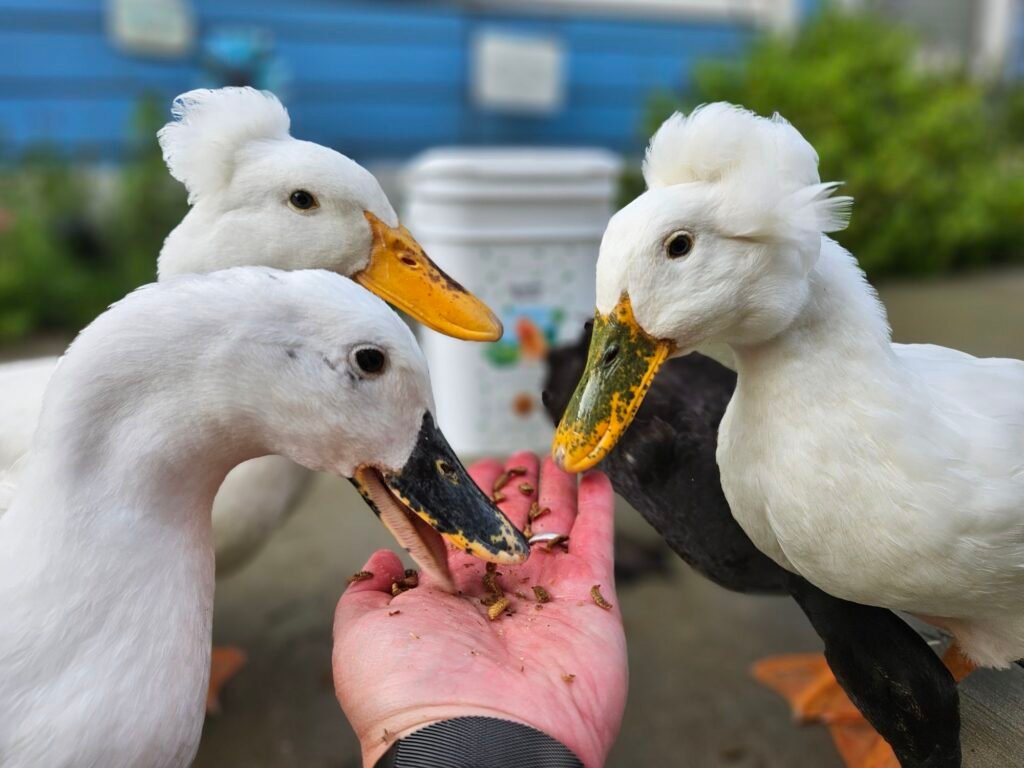
🐛 Flock Favorite: Grubblies by Grubbly Farms
Our ducks go crazy for Grubblies—a protein- and calcium-rich treat made from black soldier fly larvae. They’re perfect during molt, laying season, or just for enrichment.
Sustainably made, nutritionally balanced, and 100% duck-approved.
Understanding Snacks and Treats in a Duck’s Diet
Treats can be one of the most fun and rewarding parts of duck keeping—both for you and your ducks. They’re great for bonding, training, enrichment, or just adding variety. But it’s important to remember: treats are not a replacement for a balanced diet.
Ducks can easily overeat treats, especially starchy or sugary ones, leading to obesity, fatty liver disease, or nutritional imbalances—especially in flocks that aren’t very active.
Here’s how to navigate snacks safely:
✅ Why Some Treats Are Good
- Freeze-dried insects (like mealworms and black soldier fly larvae) offer high-quality protein and calcium, especially useful for laying ducks, molting birds, or ducklings in transition.
- Leafy greens in water bowls mimic natural foraging behavior and keep ducks entertained while also adding vitamins and hydration.
- Plain Cheerios, oats, and plain cornflakes (no sugar or salt) are great for scattering to encourage foraging. These provide simple carbohydrates and are low in fat.
- Cooked plain pasta or rice, in small amounts, can be fun for enrichment and pecking games, especially when chopped and served in water.
These treats are best offered after your ducks have eaten their regular feed so they don’t fill up on less-nutritious extras.
⚠️ Why Some Snacks Should Be Limited
- Whole grain bread and unsalted popcorn are better options than white bread or processed snacks, but they’re still low in nutrition. Use only for bonding or training purposes, not as routine snacks.
- Cooked grains like barley or quinoa are fine in small portions but may quickly add unnecessary calories if overfed.
- Commercial waterfowl treats (like duck biscuits or snack blends) can be convenient but should be checked for added salt, sugar, or unnecessary fillers.
❌ Why Some Snacks Are Harmful
- Chips, pretzels, crackers, and processed snacks are too salty and fatty. Ducks’ kidneys can’t handle high sodium, and salt toxicity can be fatal.
- Cookies, cakes, and candy contain sugar, dairy, and often preservatives that ducks cannot digest properly.
- Chocolate is toxic to ducks just like it is to dogs and cats—never feed it in any form.
- Flavored cereals and granola are usually packed with sugar and additives. Even small amounts are a poor choice for ducks.
💡 Keep It Under 10%
A good rule of thumb is to make sure treats make up no more than 10% of your ducks’ daily intake. This ensures their main diet remains balanced and nutrient-rich.
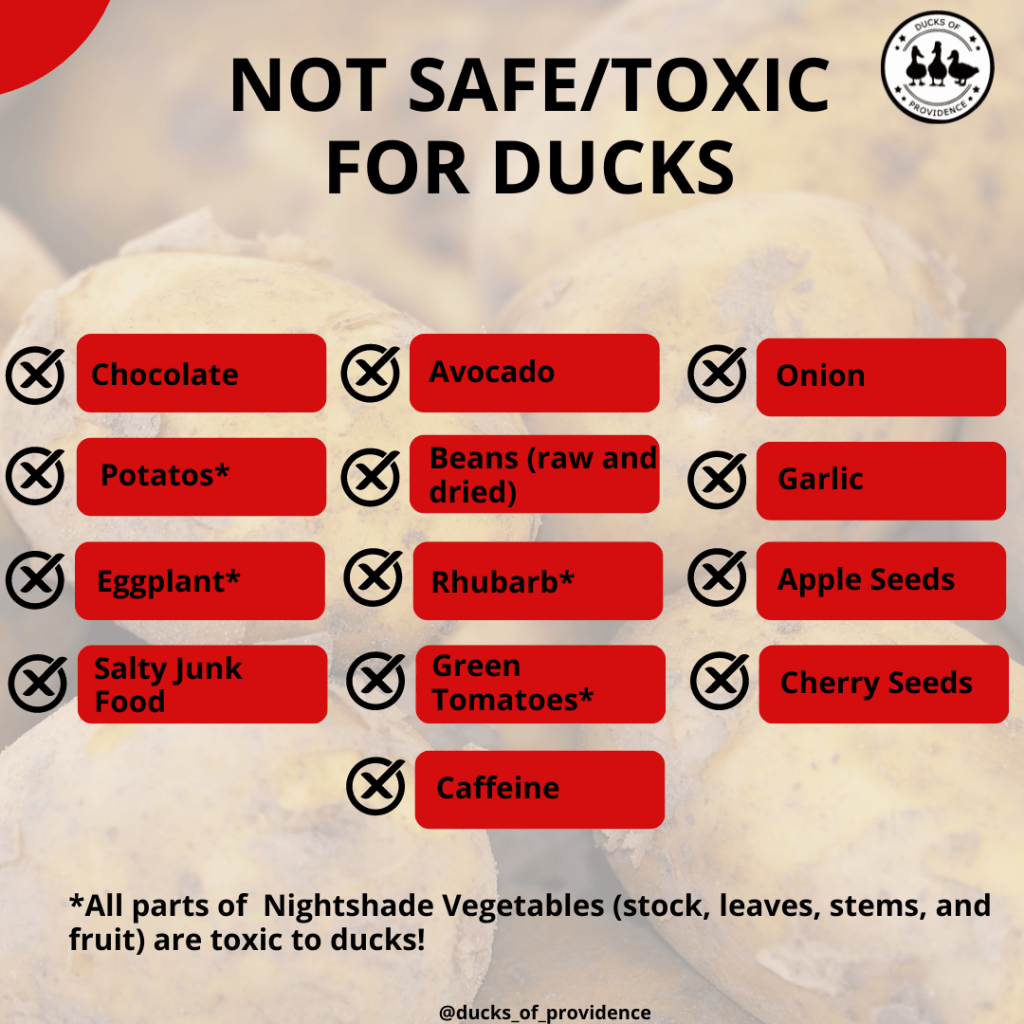
Garden and Foraged Plants Ducks Can and Can’t Eat
If your ducks free-range or you like to forage for them, it’s essential to know which wild plants and garden greenery are safe. Many common plants are perfectly fine, but others—like foxglove or tomato leaves—are toxic.
This table outlines safe plants to feed and dangerous ones to avoid in your backyard or local green spaces.
| Plant Name | Safe to Feed? | Notes |
|---|---|---|
| Dandelion | ✅ Good | Whole plant is edible; excellent forage item |
| Clover | ✅ Good | Nutritious and duck-safe; white and red varieties are both fine |
| Chickweed | ✅ Good | Soft, high-moisture weed; ducks love foraging for it |
| Duckweed | ✅ Good | Nutrient-dense aquatic plant; excellent natural food source |
| Plantain (broadleaf) | ✅ Good | Common yard weed; high in vitamins |
| Grass (chemical-free) | ✅ Good | Safe to nibble if untreated |
| Tomato (leaves/stems) | ❌ Bad | Toxic parts; only ripe fruit (in moderation) is safe |
| Eggplant leaves | ❌ Bad | Toxic like other nightshades |
| Potato leaves | ❌ Bad | Green parts are especially high in solanine (a toxic alkaloid) |
| Rhubarb (leaves) | ❌ Bad | Oxalic acid in leaves is toxic; avoid entirely |
| Foxglove | ❌ Bad | Extremely toxic; even small amounts can cause cardiac failure |
| Azalea | ❌ Bad | Contains grayanotoxins; toxic even in small quantities |
| Lily (all parts) | ❌ Bad | Potentially fatal to waterfowl |
| Nightshade (general group) | ❌ Bad | Includes deadly nightshade, bittersweet nightshade—highly toxic |
| Buttercup | ❌ Bad | Causes oral irritation and digestive upset |
| Morning glory | ❌ Bad | Seeds are toxic and hallucinogenic; avoid plant entirely |
| Oleander | ❌ Bad | Extremely toxic; never allow ducks near it |
| Hydrangea | ❌ Bad | Contains cyanogenic glycosides; toxic to many species |
| Ferns (some varieties) | ⚠️ Caution | Not all are toxic, but best to avoid unless clearly identified |
| Grass treated with pesticides | ❌ Bad | Lawn chemicals and herbicides are harmful even in small amounts |
For more information, refer to our comprehensive list of poisonous plants.
Understanding Garden and Foraged Plants for Ducks
If your ducks free-range or have access to a yard or pond, they will naturally explore and nibble on plants. This can be a wonderful source of enrichment—and many common weeds and wild plants are actually nutritious, duck-safe, and foraged instinctively.
However, not all plants are safe. Ducks don’t always recognize toxic species, and with their tendency to taste-test everything, it’s your job as their keeper to make sure their environment is free from danger.

Here’s what every duck parent should know:
✅ Why Safe Plants Are So Valuable
- Dandelions, clover, chickweed, duckweed, and plantain (the weed, not the fruit) are all safe and often nutrient-rich. They can be found in lawns, meadows, and pond edges—and are packed with minerals, fiber, and hydration.
- Duckweed, in particular, is a protein-rich aquatic plant often used in natural waterfowl diets. It grows in still water and can be collected for feeding.
- Untreated grass and common broadleaf weeds offer variety, aid digestion, and help ducks self-select greens to balance their diet.
If you want to actively forage for your ducks, focus on pesticide-free areas and learn to identify the safest plants accurately.
❌ Why Some Plants Are Dangerous
- Nightshade family plants like tomato, potato, and eggplant leaves contain solanine, a glycoalkaloid that affects the nervous system. Only the ripe fruit (like tomatoes) is safe—and only in moderation.
- Rhubarb, particularly the leaves, is toxic due to high levels of oxalic acid, which can damage kidneys and interfere with calcium metabolism.
- Foxglove, oleander, azaleas, and lilies are highly toxic and potentially fatal, even in small amounts. These plants affect the heart or nervous system and should never be grown near duck pens or runs.
- Hydrangeas, buttercups, and morning glories contain various compounds that irritate the digestive tract or are outright poisonous.
- Grass or weeds treated with herbicides or fertilizers may not look dangerous but can cause long-term organ damage or sudden illness—even if only trace amounts are ingested.
⚠️ Why Identification and Control Matter
- Young ducklings are especially vulnerable and more likely to nibble indiscriminately.
- Garden beds, ornamental landscapes, and wild hedgerows often contain mixed species. If you’re unsure whether a plant is safe, it’s best to remove access or fence it off.
- Consider planting a duck-safe forage patch with safe greens like kale, collard greens, and nasturtiums to give your ducks variety without risk.
💡 Pro Tip
Flock safety starts with plant awareness. Keep a copy of toxic plant lists handy (or in your duck first aid kit), and walk your property regularly to check for new growth, especially in spring and fall.
Final Thoughts on Choosing Safe Foods for Ducks
Feeding your ducks doesn’t have to be complicated—but it does require intention. With so many foods available in our kitchens, gardens, and backyards, it’s essential to know what’s safe, what’s best in moderation, and what to keep out of reach.
This guide is meant to help you make confident, informed decisions grounded in nutritional science and real-world experience. Whether you’re offering fresh peas from your garden, tossing treats into a water bowl for enrichment, or scanning your backyard for toxic plants, every small choice contributes to your ducks’ long-term health and happiness.
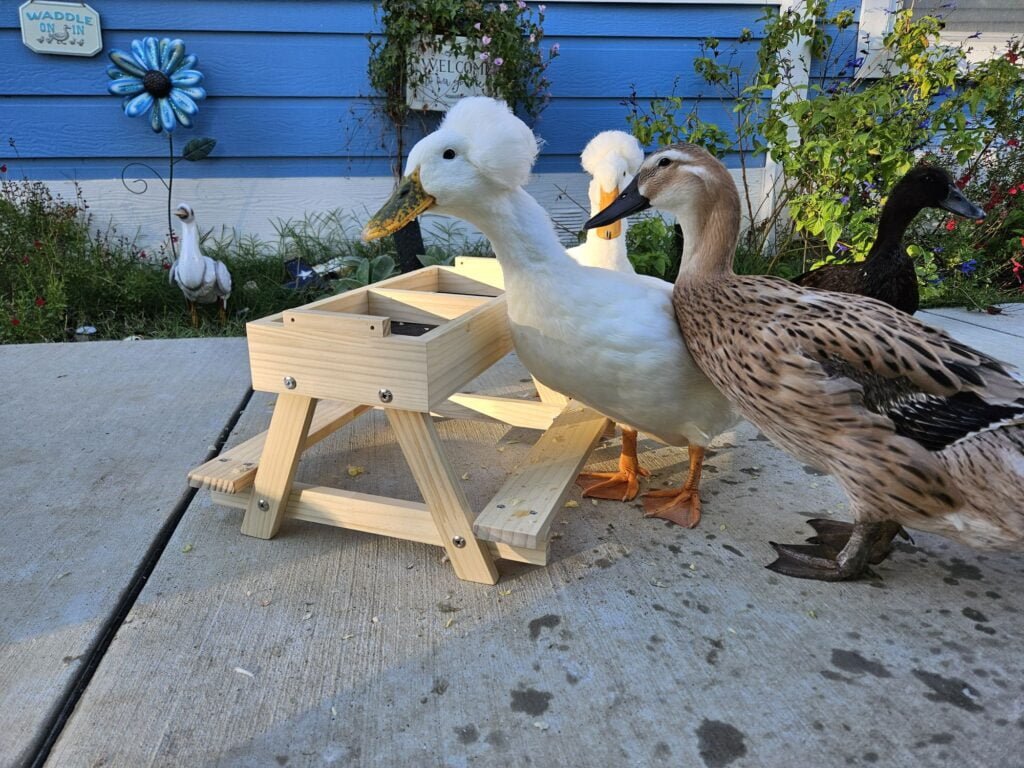
Balance matters—but it’s not one-size-fits-all
A common rule of thumb is that about 90% of a duck’s diet should come from a complete, nutritionally balanced feed, with 10% or less made up of treats and extras. But this doesn’t apply equally to all foods—or all ducks.
Leafy greens are an exception—they’re low in calories, rich in nutrients, and can make up a much larger portion of the diet, especially for pet ducks or those with limited foraging access.
The ideal balance also depends on your duck’s age, activity level, and purpose:
- Pet ducks who aren’t laying can safely enjoy more greens, enrichment treats, and variety.
- Laying hens and breeding ducks need a stricter nutritional balance, especially in calcium, protein, and energy, to support egg health.
- Molting ducks and growing ducklings require extra protein and careful management of carbohydrates.
The key is to focus on whole, nutrient-dense options and treat extras like what they are—additions, not replacements.
Observe and adapt—Every duck is unique. What one duck loves, another might ignore. In our flock, some go wild for tomatoes, while others beg for blueberries—and a few turn their bills up at both! Don’t be discouraged if your ducks don’t like something you offer. Try a variety of safe foods and learn what they enjoy. Over time, you’ll get to know their individual tastes just like you would with any beloved pet.
We hope this guide becomes a go-to reference as you care for your flock. Your ducks trust you—and we’re here to help you give them the healthiest, happiest lives possible.
For more guidance, refer to our other duck nutrition articles, which include complete feed comparisons and more, available below.
Related Articles
- Feeding Ducks: A Guide to Keeping Your Flock Happy and Healthy
- What do Pet Ducks Eat? A Guide to a Healthy and Nutritious Pet Duck Diet
- Essential Nutritional Needs of Ducks: A Complete Overview
- Commercial Duck Feed Comparison
- The Ultimate Guide to Healthy Duck Snacks: Treats Your Ducks Will Love
- Toxic Plants for Ducks: What You Need to Know

